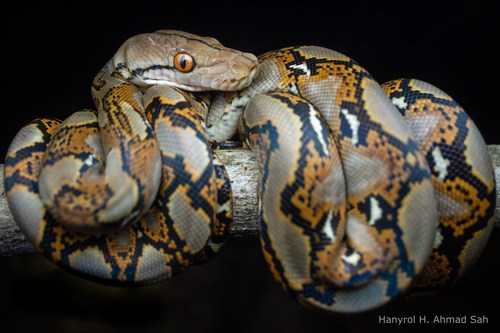
Reticulated Python
The reticulated python, Malayopython reticulatus, captivates with its mesmerizing scale patterns and impressive length. Dwelling in Southeast Asia's lush habitats, it plays a pivotal role as a top predator, controlling populations of rodents and other small animals through its stealthy, constricting hunting technique.
Least Concern
Conservation Status
Unknown
Population Trend
Characteristics
The Malayopython reticulatus, also known as the reticulated python, is renowned for its striking geometric pattern of scales, featuring intricate networks of dark lines on a lighter background. It is the world's longest snake, often exceeding 20 feet. Native to Southeast Asia, this python inhabits tropical forests, wetlands, and grasslands. It is an ambush predator, using its immense strength to constrict prey.
Distribution Range of the Reticulated Python
Malayopython reticulatus, commonly known as the reticulated python, is native to Southeast Asia. Its geographical distribution includes countries such as Bangladesh, Myanmar, Thailand, Laos, Cambodia, Vietnam, Malaysia, Singapore, Indonesia, and the Philippines. It is also found on a number of islands in this region, including the Nicobar Islands and some parts of Sulawesi.
Reticulated Python's Habitat
Environmental Conditions
The reticulated python typically inhabits tropical rainforests, woodlands, and grasslands. It is often found near bodies of water and is known to be a strong swimmer. The climate in these regions is typically warm and humid, with significant rainfall throughout the year.
Ecological Niche
As a large constrictor, Malayopython reticulatus primarily preys on mammals and birds, using its size and strength to subdue its prey. It plays a role in controlling the populations of these species. The reticulated python is also known for its adaptability, sometimes being found in agricultural areas and near human settlements, where it can find rodents and other small animals.
Copyright @ Nature Style Limited. All Rights Reserved.
 English
English